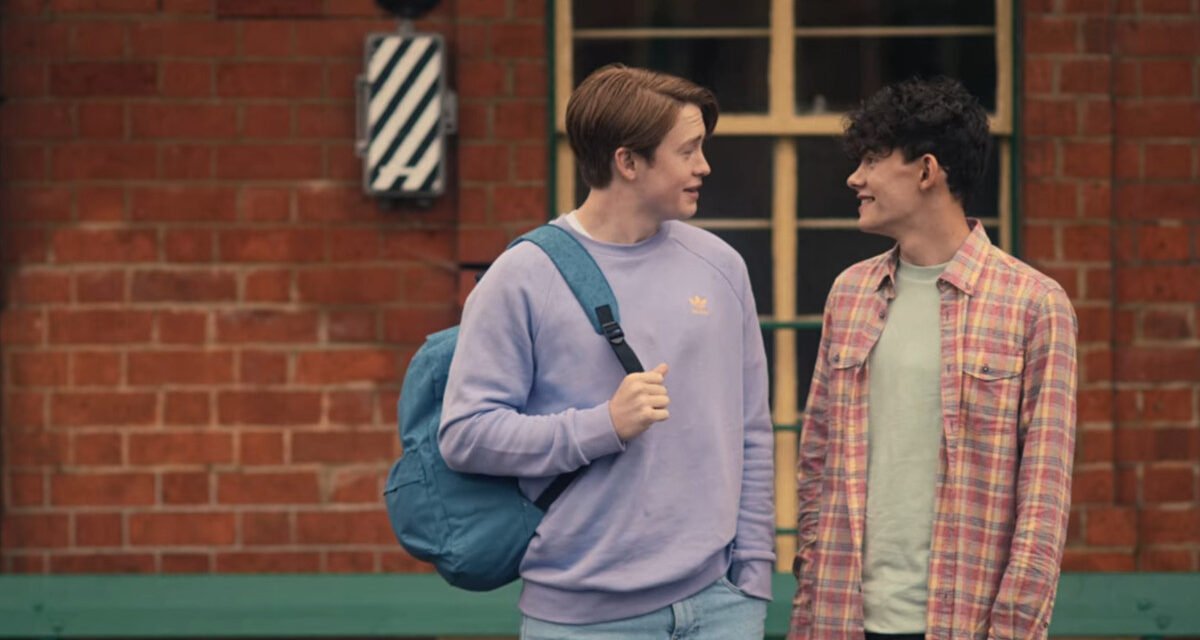Heartstopper’s Revolution: How the Netflix Hit is Redefining Queerness on Screen
From the moment Charlie and Nick’s knees brush, the electricity is so palpable that viewers don’t even need the visual queue. These literal sparks appear on screen as small lightning bolts that light up when their pinkies clasp or their eyes lock, and the sweetness of these moments excel at reminding audiences of the excitement first love brings. The small instances of animation, called “Heartstopper” moments, are only one unique element that makes Heartstopper a fresh and endearing take on young queer romance.
Heartstopper Episode 8: “Boyfriend” featuring Joe Locke (right) and Kit Connor (left)
In April, Netflix dropped Heartstopper, an adaptation of Alice Oseman’s wildly successful graphic novel. The show follows the relationship of Charlie (Joe Locke), an openly gay sophomore, and Nick (Kit Connor), the seemingly straight rugby star, as they explore what it means to fall in love in an environment that is not entirely accepting of queerness. Despite the focus on Nick’s journey in discovering his sexuality, the show is unique in its exploration of life after you come out as queer. In an interview with GQ, Locke says, “There are a lot of stories about coming out, but there are not as many stories about the actual queer experience post-coming out and how just because you're out, doesn't mean everything is magically better.”
Part of the reason that audiences have responded so well to Heartstopper is because of the candid and truthful representation. Unlike popular shows depicting queer relationships among teenagers that are played majorily by adults, Heartstopper features a cast comprised almost entirely of teens. In addition, the show intentionally chooses not to dramatize or sexualize teen romance. The overwhelmingly light color palette echoes the earnest sentiments and emotions of the characters. Although Heartstopper captures the anxiety surrounding the struggle of understanding your sexuality, it does so in a way that emphasizes the joy of being young and in love.
Scene from Heartstopper #1 by Alice Oseman featuring Nick (top) and Charlie (bottom)
The show, which has topped the charts on Netflix and received an incredible score of 100% on rotten tomatoes, remains faithful to the graphic novel from which it was adapted. Alice Oseman originally created Nick and Charlie as characters in another novel, “Solitaire,” written when she was 17 and still unsure of her own sexuality. Through writing, Oseman was able to explore her own relationship to queerness, and in turn, this inspired the stories she wrote. Originally published as a webcomic, Heartstopper received an incredibly enthusiastic response from fans, prompting Oseman to adapt it as a graphic novel. She continued the series to encompass three other novels, eliciting hope from fans for following seasons.
Although Oseman wrote Heartstopper at 27, she maintains that she “always treat[s] teenage characters as mature human beings,” adding that, “teenagers don’t feel like teenagers; teenagers are the oldest that they’ve ever been.” This translates beautifully onto the screen, aided by the small animated “Heartstopper” moments. Whether snowflakes fall around Nick and Charlie or sparks fly from their physical connection, these moments capture the pure rush of feeling that little actions have when you’re in love. These visuals are a strong reminder of the intensity of love and how this translates to being a teenager. Instead of diminishing teen romance, Oseman holds it up as a pure and valid experience that can help you parse through your identity. So, if you find yourself in need of a new TV show, I cannot recommend Heartstopper enough.


